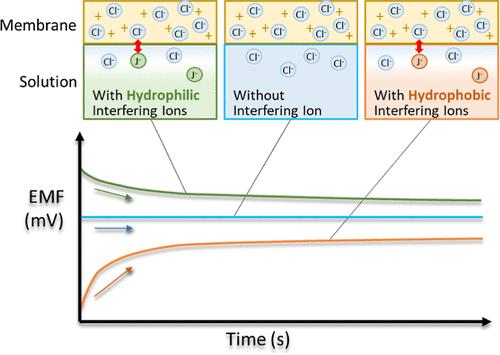当前位置:
X-MOL 学术
›
Anal. Chem.
›
论文详情
Our official English website, www.x-mol.net, welcomes your
feedback! (Note: you will need to create a separate account there.)
Detection of Interfering Ions Using Ion Flux Phenomena in Flow-Through Cl-ISEs with Ion Exchange Membranes
Analytical Chemistry ( IF 6.7 ) Pub Date : 2023-05-04 , DOI: 10.1021/acs.analchem.3c00366 Atsushi Kishioka 1 , Yufuku Matsushita 1 , Masafumi Miyake 2
Analytical Chemistry ( IF 6.7 ) Pub Date : 2023-05-04 , DOI: 10.1021/acs.analchem.3c00366 Atsushi Kishioka 1 , Yufuku Matsushita 1 , Masafumi Miyake 2
Affiliation

|
Ion-selective electrodes (ISEs) are among the most successful electrochemical sensors used in various applications because of their ability to measure electrolyte concentrations in liquids easily. It is common practice to suppress ion fluxes through the ion-sensitive membranes in ISEs because such fluxes worsen the lower limit of detection. In this study, we propose a method to detect interfering ions using this ion flux phenomenon. As a proof of principle, a flow-type Cl-ISE based on an ion exchange membrane loaded with the target ion chloride was used to acquire transient potential profiles during standstill after the introduction of liquids containing various ion species. When the target ion of the ion-sensitive membrane was measured, there was almost no change in potential over time. In contrast, when hydrophilic interfering ions were measured, the potential gradually decreased, and when hydrophobic interfering ions were measured, the potential gradually increased. The direction and intensity of these changes over time depended on the ion species and concentrations. The main reason for these potential changes is presumed to be the change in the local ionic composition of the sample near the sensing membrane due to ion exchange between the sample and membrane. This phenomenon could not be observed in a hydrophobic ion exchanger membrane doped with a quaternary ammonium salt and was characteristically observable using hydrophilic ion exchange membranes with a high charge density and a high ion diffusion rate. Finally, using a high-throughput flow-type system, we demonstrated the detection of interfering ions in solutions containing multiple ion species by using the ion flux phenomenon.
中文翻译:

使用离子交换膜的流通 Cl-ISE 中的离子通量现象检测干扰离子
离子选择电极 (ISE) 是用于各种应用的最成功的电化学传感器之一,因为它们能够轻松测量液体中的电解质浓度。通常的做法是抑制离子通量通过 ISE 中的离子敏感膜,因为这种通量会降低检测下限。在这项研究中,我们提出了一种利用这种离子通量现象检测干扰离子的方法。作为原理证明,基于装有目标离子氯化物的离子交换膜的流式 Cl-ISE 用于在引入含有各种离子种类的液体后的静止期间获取瞬态电位曲线。当测量离子敏感膜的目标离子时,电位随时间几乎没有变化。相反,当测量亲水性干扰离子时,电位逐渐降低,当测定疏水性干扰离子时,电位逐渐升高。这些随时间变化的方向和强度取决于离子种类和浓度。这些潜在变化的主要原因被认为是由于样品和膜之间的离子交换导致传感膜附近样品的局部离子组成发生变化。这种现象在掺杂有季铵盐的疏水性离子交换膜中观察不到,而使用具有高电荷密度和高离子扩散速率的亲水性离子交换膜可以观察到。最后,使用高通量流式系统,我们展示了利用离子通量现象检测含有多种离子种类的溶液中的干扰离子。
更新日期:2023-05-04
中文翻译:

使用离子交换膜的流通 Cl-ISE 中的离子通量现象检测干扰离子
离子选择电极 (ISE) 是用于各种应用的最成功的电化学传感器之一,因为它们能够轻松测量液体中的电解质浓度。通常的做法是抑制离子通量通过 ISE 中的离子敏感膜,因为这种通量会降低检测下限。在这项研究中,我们提出了一种利用这种离子通量现象检测干扰离子的方法。作为原理证明,基于装有目标离子氯化物的离子交换膜的流式 Cl-ISE 用于在引入含有各种离子种类的液体后的静止期间获取瞬态电位曲线。当测量离子敏感膜的目标离子时,电位随时间几乎没有变化。相反,当测量亲水性干扰离子时,电位逐渐降低,当测定疏水性干扰离子时,电位逐渐升高。这些随时间变化的方向和强度取决于离子种类和浓度。这些潜在变化的主要原因被认为是由于样品和膜之间的离子交换导致传感膜附近样品的局部离子组成发生变化。这种现象在掺杂有季铵盐的疏水性离子交换膜中观察不到,而使用具有高电荷密度和高离子扩散速率的亲水性离子交换膜可以观察到。最后,使用高通量流式系统,我们展示了利用离子通量现象检测含有多种离子种类的溶液中的干扰离子。


















































 京公网安备 11010802027423号
京公网安备 11010802027423号